Yuzheng Zhuang
Structured Preference Optimization for Vision-Language Long-Horizon Task Planning
Feb 28, 2025Abstract:Existing methods for vision-language task planning excel in short-horizon tasks but often fall short in complex, long-horizon planning within dynamic environments. These challenges primarily arise from the difficulty of effectively training models to produce high-quality reasoning processes for long-horizon tasks. To address this, we propose Structured Preference Optimization (SPO), which aims to enhance reasoning and action selection in long-horizon task planning through structured preference evaluation and optimized training strategies. Specifically, SPO introduces: 1) Preference-Based Scoring and Optimization, which systematically evaluates reasoning chains based on task relevance, visual grounding, and historical consistency; and 2) Curriculum-Guided Training, where the model progressively adapts from simple to complex tasks, improving its generalization ability in long-horizon scenarios and enhancing reasoning robustness. To advance research in vision-language long-horizon task planning, we introduce ExtendaBench, a comprehensive benchmark covering 1,509 tasks across VirtualHome and Habitat 2.0, categorized into ultra-short, short, medium, and long tasks. Experimental results demonstrate that SPO significantly improves reasoning quality and final decision accuracy, outperforming prior methods on long-horizon tasks and underscoring the effectiveness of preference-driven optimization in vision-language task planning. Specifically, SPO achieves a +5.98% GCR and +4.68% SR improvement in VirtualHome and a +3.30% GCR and +2.11% SR improvement in Habitat over the best-performing baselines.
Mem2Ego: Empowering Vision-Language Models with Global-to-Ego Memory for Long-Horizon Embodied Navigation
Feb 20, 2025Abstract:Recent advancements in Large Language Models (LLMs) and Vision-Language Models (VLMs) have made them powerful tools in embodied navigation, enabling agents to leverage commonsense and spatial reasoning for efficient exploration in unfamiliar environments. Existing LLM-based approaches convert global memory, such as semantic or topological maps, into language descriptions to guide navigation. While this improves efficiency and reduces redundant exploration, the loss of geometric information in language-based representations hinders spatial reasoning, especially in intricate environments. To address this, VLM-based approaches directly process ego-centric visual inputs to select optimal directions for exploration. However, relying solely on a first-person perspective makes navigation a partially observed decision-making problem, leading to suboptimal decisions in complex environments. In this paper, we present a novel vision-language model (VLM)-based navigation framework that addresses these challenges by adaptively retrieving task-relevant cues from a global memory module and integrating them with the agent's egocentric observations. By dynamically aligning global contextual information with local perception, our approach enhances spatial reasoning and decision-making in long-horizon tasks. Experimental results demonstrate that the proposed method surpasses previous state-of-the-art approaches in object navigation tasks, providing a more effective and scalable solution for embodied navigation.
3D-MoE: A Mixture-of-Experts Multi-modal LLM for 3D Vision and Pose Diffusion via Rectified Flow
Jan 28, 2025



Abstract:3D vision and spatial reasoning have long been recognized as preferable for accurately perceiving our three-dimensional world, especially when compared with traditional visual reasoning based on 2D images. Due to the difficulties in collecting high-quality 3D data, research in this area has only recently gained momentum. With the advent of powerful large language models (LLMs), multi-modal LLMs for 3D vision have been developed over the past few years. However, most of these models focus primarily on the vision encoder for 3D data. In this paper, we propose converting existing densely activated LLMs into mixture-of-experts (MoE) models, which have proven effective for multi-modal data processing. In addition to leveraging these models' instruction-following capabilities, we further enable embodied task planning by attaching a diffusion head, Pose-DiT, that employs a novel rectified flow diffusion scheduler. Experimental results on 3D question answering and task-planning tasks demonstrate that our 3D-MoE framework achieves improved performance with fewer activated parameters.
SpatialCoT: Advancing Spatial Reasoning through Coordinate Alignment and Chain-of-Thought for Embodied Task Planning
Jan 17, 2025Abstract:Spatial reasoning is an essential problem in embodied AI research. Efforts to enhance spatial reasoning abilities through supplementary spatial data and fine-tuning have proven limited and ineffective when addressing complex embodied tasks, largely due to their dependence on language-based outputs. While some approaches have introduced a point-based action space to mitigate this issue, they fall short in managing more intricate tasks within complex environments. This deficiency arises from their failure to fully exploit the inherent thinking and reasoning capabilities that are fundamental strengths of Vision-Language Models (VLMs). To address these limitations, we propose a novel approach named SpatialCoT, specifically designed to bolster the spatial reasoning capabilities of VLMs. Our approach comprises two stages: spatial coordinate bi-directional alignment, which aligns vision-language inputs with spatial coordinates, and chain-of-thought spatial grounding, which harnesses the reasoning capabilities of language models for advanced spatial reasoning. We evaluate SpatialCoT on challenging navigation and manipulation tasks, both in simulation and real-world settings. Experimental results demonstrate that our method significantly outperforms previous state-of-the-art approaches in both tasks.
Actra: Optimized Transformer Architecture for Vision-Language-Action Models in Robot Learning
Aug 02, 2024Abstract:Vision-language-action models have gained significant attention for their ability to model trajectories in robot learning. However, most existing models rely on Transformer models with vanilla causal attention, which we find suboptimal for processing segmented multi-modal sequences. Additionally, the autoregressive generation approach falls short in generating multi-dimensional actions. In this paper, we introduce Actra, an optimized Transformer architecture featuring trajectory attention and learnable action queries, designed for effective encoding and decoding of segmented vision-language-action trajectories in robot imitation learning. Furthermore, we devise a multi-modal contrastive learning objective to explicitly align different modalities, complementing the primary behavior cloning objective. Through extensive experiments conducted across various environments, Actra exhibits substantial performance improvement when compared to state-of-the-art models in terms of generalizability, dexterity, and precision.
ROS-LLM: A ROS framework for embodied AI with task feedback and structured reasoning
Jun 28, 2024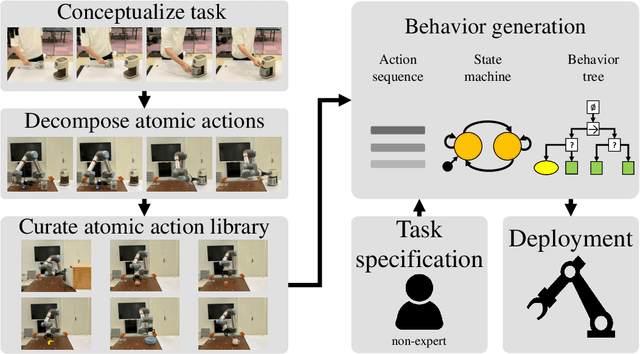
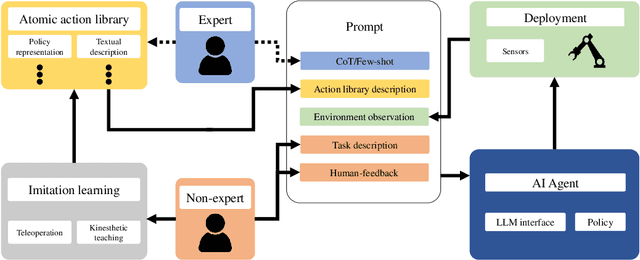
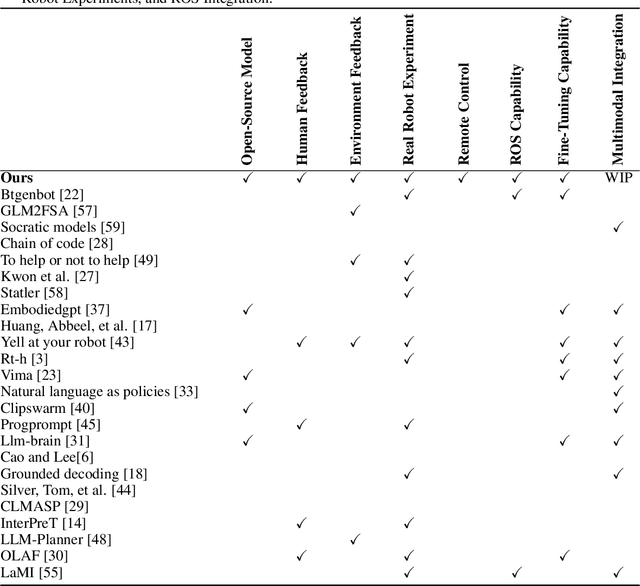
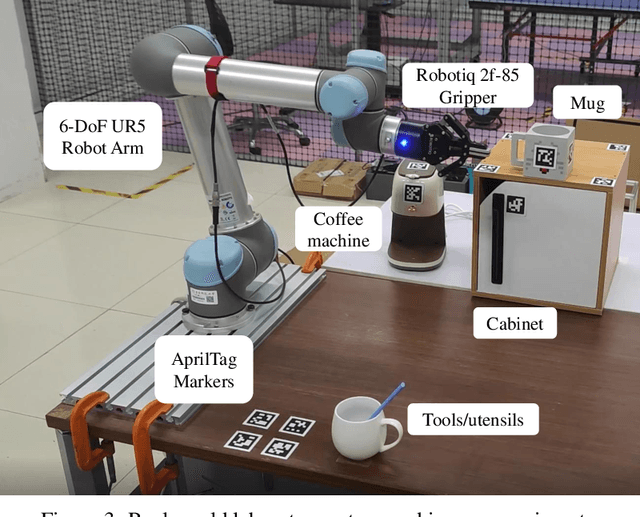
Abstract:We present a framework for intuitive robot programming by non-experts, leveraging natural language prompts and contextual information from the Robot Operating System (ROS). Our system integrates large language models (LLMs), enabling non-experts to articulate task requirements to the system through a chat interface. Key features of the framework include: integration of ROS with an AI agent connected to a plethora of open-source and commercial LLMs, automatic extraction of a behavior from the LLM output and execution of ROS actions/services, support for three behavior modes (sequence, behavior tree, state machine), imitation learning for adding new robot actions to the library of possible actions, and LLM reflection via human and environment feedback. Extensive experiments validate the framework, showcasing robustness, scalability, and versatility in diverse scenarios, including long-horizon tasks, tabletop rearrangements, and remote supervisory control. To facilitate the adoption of our framework and support the reproduction of our results, we have made our code open-source. You can access it at: https://github.com/huawei-noah/HEBO/tree/master/ROSLLM.
A Survey on Vision-Language-Action Models for Embodied AI
May 23, 2024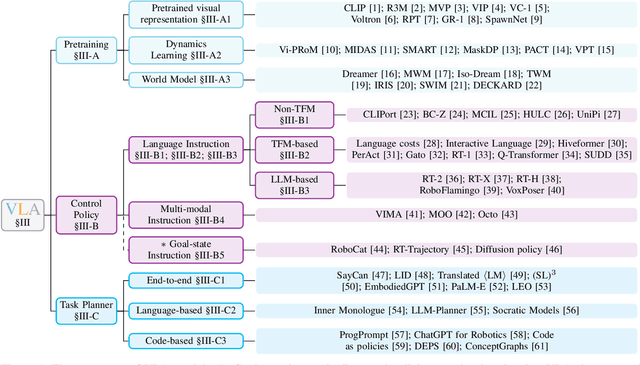
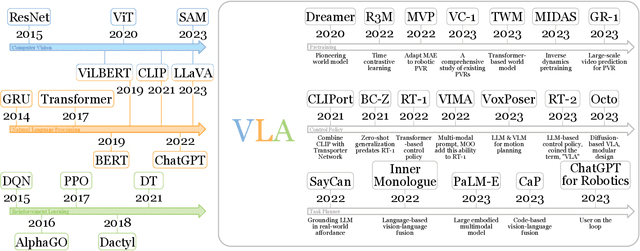


Abstract:Deep learning has demonstrated remarkable success across many domains, including computer vision, natural language processing, and reinforcement learning. Representative artificial neural networks in these fields span convolutional neural networks, Transformers, and deep Q-networks. Built upon unimodal neural networks, numerous multi-modal models have been introduced to address a range of tasks such as visual question answering, image captioning, and speech recognition. The rise of instruction-following robotic policies in embodied AI has spurred the development of a novel category of multi-modal models known as vision-language-action models (VLAs). Their multi-modality capability has become a foundational element in robot learning. Various methods have been proposed to enhance traits such as versatility, dexterity, and generalizability. Some models focus on refining specific components through pretraining. Others aim to develop control policies adept at predicting low-level actions. Certain VLAs serve as high-level task planners capable of decomposing long-horizon tasks into executable subtasks. Over the past few years, a myriad of VLAs have emerged, reflecting the rapid advancement of embodied AI. Therefore, it is imperative to capture the evolving landscape through a comprehensive survey.
SCALE: Self-Correcting Visual Navigation for Mobile Robots via Anti-Novelty Estimation
Apr 16, 2024Abstract:Although visual navigation has been extensively studied using deep reinforcement learning, online learning for real-world robots remains a challenging task. Recent work directly learned from offline dataset to achieve broader generalization in the real-world tasks, which, however, faces the out-of-distribution (OOD) issue and potential robot localization failures in a given map for unseen observation. This significantly drops the success rates and even induces collision. In this paper, we present a self-correcting visual navigation method, SCALE, that can autonomously prevent the robot from the OOD situations without human intervention. Specifically, we develop an image-goal conditioned offline reinforcement learning method based on implicit Q-learning (IQL). When facing OOD observation, our novel localization recovery method generates the potential future trajectories by learning from the navigation affordance, and estimates the future novelty via random network distillation (RND). A tailored cost function searches for the candidates with the least novelty that can lead the robot to the familiar places. We collect offline data and conduct evaluation experiments in three real-world urban scenarios. Experiment results show that SCALE outperforms the previous state-of-the-art methods for open-world navigation with a unique capability of localization recovery, significantly reducing the need for human intervention. Code is available at https://github.com/KubeEdge4Robotics/ScaleNav.
Articulated Object Manipulation with Coarse-to-fine Affordance for Mitigating the Effect of Point Cloud Noise
Mar 07, 2024Abstract:3D articulated objects are inherently challenging for manipulation due to the varied geometries and intricate functionalities associated with articulated objects.Point-level affordance, which predicts the per-point actionable score and thus proposes the best point to interact with, has demonstrated excellent performance and generalization capabilities in articulated object manipulation. However, a significant challenge remains: while previous works use perfect point cloud generated in simulation, the models cannot directly apply to the noisy point cloud in the real-world. To tackle this challenge, we leverage the property of real-world scanned point cloud that, the point cloud becomes less noisy when the camera is closer to the object. Therefore, we propose a novel coarse-to-fine affordance learning pipeline to mitigate the effect of point cloud noise in two stages. In the first stage, we learn the affordance on the noisy far point cloud which includes the whole object to propose the approximated place to manipulate. Then, we move the camera in front of the approximated place, scan a less noisy point cloud containing precise local geometries for manipulation, and learn affordance on such point cloud to propose fine-grained final actions. The proposed method is thoroughly evaluated both using large-scale simulated noisy point clouds mimicking real-world scans, and in the real world scenarios, with superiority over existing methods, demonstrating the effectiveness in tackling the noisy real-world point cloud problem.
VOLTA: Diverse and Controllable Question-Answer Pair Generation with Variational Mutual Information Maximizing Autoencoder
Jul 03, 2023Abstract:Previous question-answer pair generation methods aimed to produce fluent and meaningful question-answer pairs but tend to have poor diversity. Recent attempts addressing this issue suffer from either low model capacity or overcomplicated architecture. Furthermore, they overlooked the problem where the controllability of their models is highly dependent on the input. In this paper, we propose a model named VOLTA that enhances generative diversity by leveraging the Variational Autoencoder framework with a shared backbone network as its encoder and decoder. In addition, we propose adding InfoGAN-style latent codes to enable input-independent controllability over the generation process. We perform comprehensive experiments and the results show that our approach can significantly improve diversity and controllability over state-of-the-art models.
 Add to Chrome
Add to Chrome Add to Firefox
Add to Firefox Add to Edge
Add to Edge